Pomeranian
Ruta Lipskija/iStock / Getty Images Plus via Getty Images
Pomeranians are a miniaturized descendant of the Spitz sled dog breeds—the Akita, Alaskan Malamute, Chow Chow, and Samoyed, just to name a few.
Originally, Poms were much larger (about 30 pounds, according to the American Pomeranian Club) and were used for herding. However, they were bred to reduce their size to what we recognize now, and today the Pomeranian is one of the smallest dog breeds, at just 6–7 inches tall and 3–7 pounds.
Pomeranian colors vary greatly; there are tri-colored, sable, brindle, merle, white, and black Pomeranians, among many other colors and patterns. They have a foxlike face, thick scruff around the neck, a square body, and a fluffy double coat.
Caring for a Pomeranian
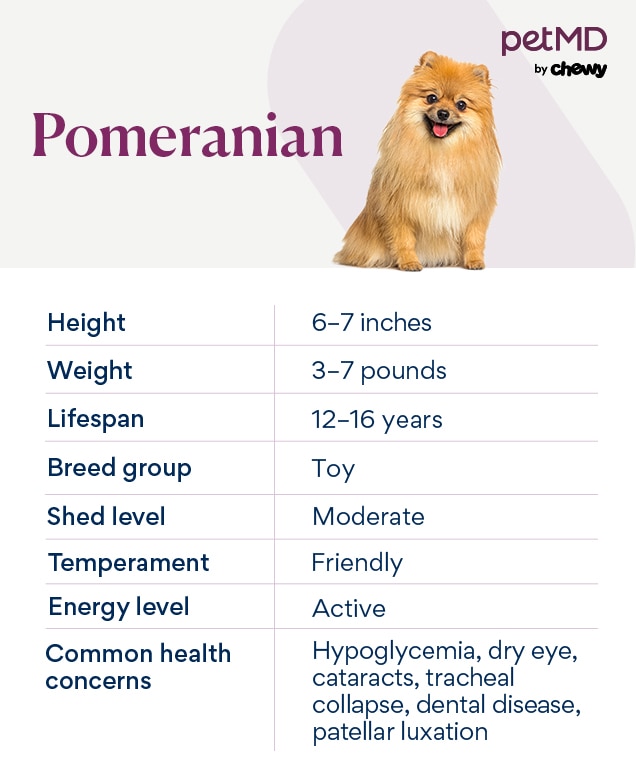
Pomeranians have large personalities in their tiny bodies. They are sassy, spunky, and often have a confidence of a much larger dog. Pomeranian dogs do well with other pets and love attention.
Poms are great companions for many types of pet parents—families, singles, and older adults included. Any while the breed can be playful, the dogs don’t require extensive outdoor activity because of their small size.
But the dogs’ long, fluffy coat requires daily upkeep and grooming to stay pretty and healthy. To make brushing easier, you can give your Pomeranian haircuts to keep their fur short.
Pomeranian Health Issues
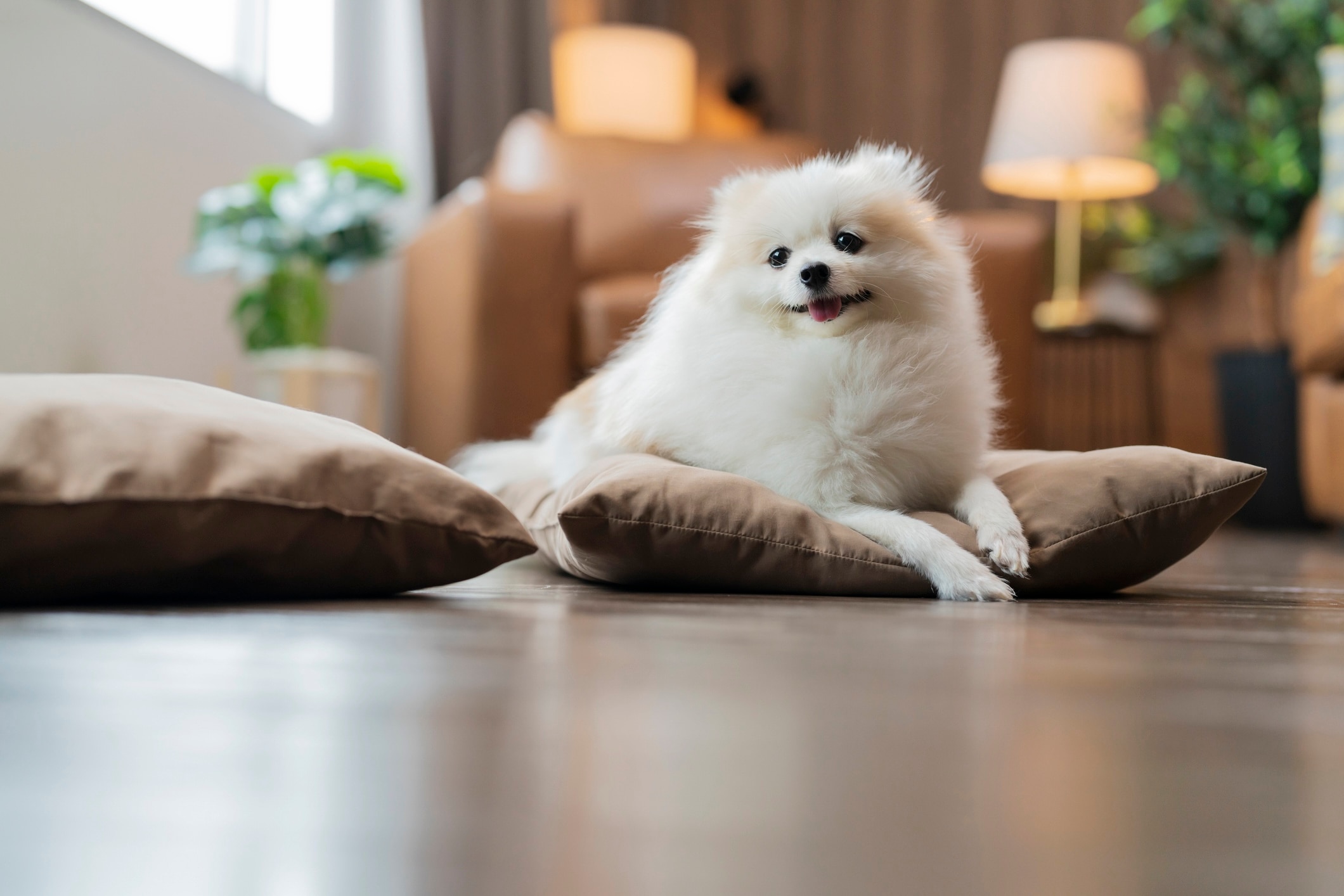
The average Pomeranian lifespan is 12–16 years, making them one of the longest-living dog breeds. But it’s possible for them to develop a few health conditions over the course of their life.
When considering bringing home a Pomeranian puppy or dog, it may be beneficial to consider health insurance and budgeting for any medical issues that may arise.
Alopecia
Pomeranians can develop symmetrical hair loss on their abdomen and thighs (alopecia). Their skin can also become dark (hyperpigmentation) but doesn’t usually become itchy.
The cause of this cosmetic condition isn’t fully understood, and it’s important to take your Pomeranian to the vet to rule out hormonal issues like Cushing’s disease or hypothyroidism.
No treatment is guaranteed to be successful, but melatonin and other medications may be helpful in some cases.
Hypoglycemia
Hypoglycemia in dogs is a sudden drop in blood sugar. This condition commonly affects small breeds and puppies under 3 months of age.
Signs of low blood sugar include:
-
Weakness
-
Stumbling
-
Shaking
-
Twitching muscles
Most cases of hypoglycemia are caused by an inadequate diet.
If your Pomeranian experiences an episode of hypoglycemia, contact your veterinarian and seek treatment immediately. Your veterinarian can work with you to find the right food and feeding schedule to prevent another episode.
A vet can also recommend glucose gels, which provide instant doses of glucose to help your dog bounce back.
Eye Problems
Pomeranians can develop several canine eye conditions, including:
-
Dry eye (keratoconjunctivitis sicca): Dry eye is a condition caused by inadequate tear production, which can cause damage and irritation to the cornea. Typical signs of dry eye are painful, red, or irritated eyes that cause a dog to squint, blink excessively, or hold their eyes shut.
-
Tear duct issues: Many tear duct issues, such as excessive tearing, can be caused by infection, genetics, inflammation, or other issues that can contribute to tear stains—dark or reddish marks that appear beneath the eyes—or a narrowing or clogging of tear ducts.
-
Cataracts: Cataracts in dogs are progressive and, over time, lead to blindness. Pomeranians can have a genetic predisposition for cataract development, or it can be secondary to diabetes mellitus. Treatment is possible through surgery.
-
Distichiasis: This condition is when the eyelashes grow abnormally inward, toward the eye. This causes irritation and can even cause eye ulcers.
Contact your veterinarian if you notice changes in your dog’s eyes, including cloudiness, redness, discharge, or changes in your Pomeranian’s vision.
Collapsing Trachea
Collapsing trachea is a condition that typically presents as a goose honk-like cough. It most often occurs in small dogs, especially those who are walked with a collar around their neck.
Your dog’s trachea, or windpipe, connects the throat to the lungs. A tracheal collapse occurs when the small rings of cartilage that maintain the tubelike shape of the trachea become too flexible, losing their strength and firmness. When a dog with tracheal collapse pulls air into their airway, the tracheal rings flatten and it’s difficult to get air into the lungs.
Treatment can include surgery, management through medication, or both.
If your Pomeranian dog is diagnosed with tracheal collapse, it’s recommended to use a harness instead of a collar when going outside. Try to avoid situations that cause your dog to become overexcited, and avoid exposing your dog to irritants, such as tobacco smoke.
Dental Disease
While all dogs can develop dental disease, small breeds like the Pomeranian are especially susceptible to the condition. A smaller mouth means more potential for teeth becoming overcrowded or growing in at odd angles. This can lead to increased amounts of trapped food, which lead to tartar buildup.
The best treatment for dental disease is proactive prevention:
-
Brush your dog’s teeth every day, using a vet-recommended toothbrush and toothpaste
-
Keep up with professional dental cleanings as your veterinarian recommends them
-
Give your Pomeranian dental chews to promote good hygiene
-
Feed your Pomeranian a dog food that supports dental health
Hip Dysplasia
Hip dysplasia is caused by a shallow hip socket and/or a small or deformed femoral head (top of the thigh bone). This causes the joint to become loose and unstable. Without treatment, hip dysplasia can cause significant pain and lead to arthritis.
Many cases of hip dysplasia typically cause minimal pain or discomfort and can be managed with medications or joint supplements. Severe cases may require surgery.
Legg-Calve-Perthes Disease
Legg-Calve-Perthes disease is a condition that affects the head of the femur and the hip joint. The femoral head experiences a loss of blood supply, which causes it to shrink and eventually leads to necrosis.
The condition is hereditary in Pomeranians and typically occurs in young dogs. The most common symptom is the slow progression of lameness in the hind limb, and treatment often requires surgery.
Patellar Luxation
Patellar luxation is a condition where the kneecap (patella) shifts sideways away from its normal position at the front of the knee. This is typically a hereditary condition, but in some cases it can be caused by trauma.
Signs of patellar luxation can be similar to hip dysplasia, including:
- Intermittent skipping or limping on three legs
- Bowlegged stance in hind limbs
- Hunched lower back
Medical treatment for a luxating patella can involve anti-inflammatory medication, weight loss, temporary exercise restrictions, and surgery.
What To Feed a Pomeranian
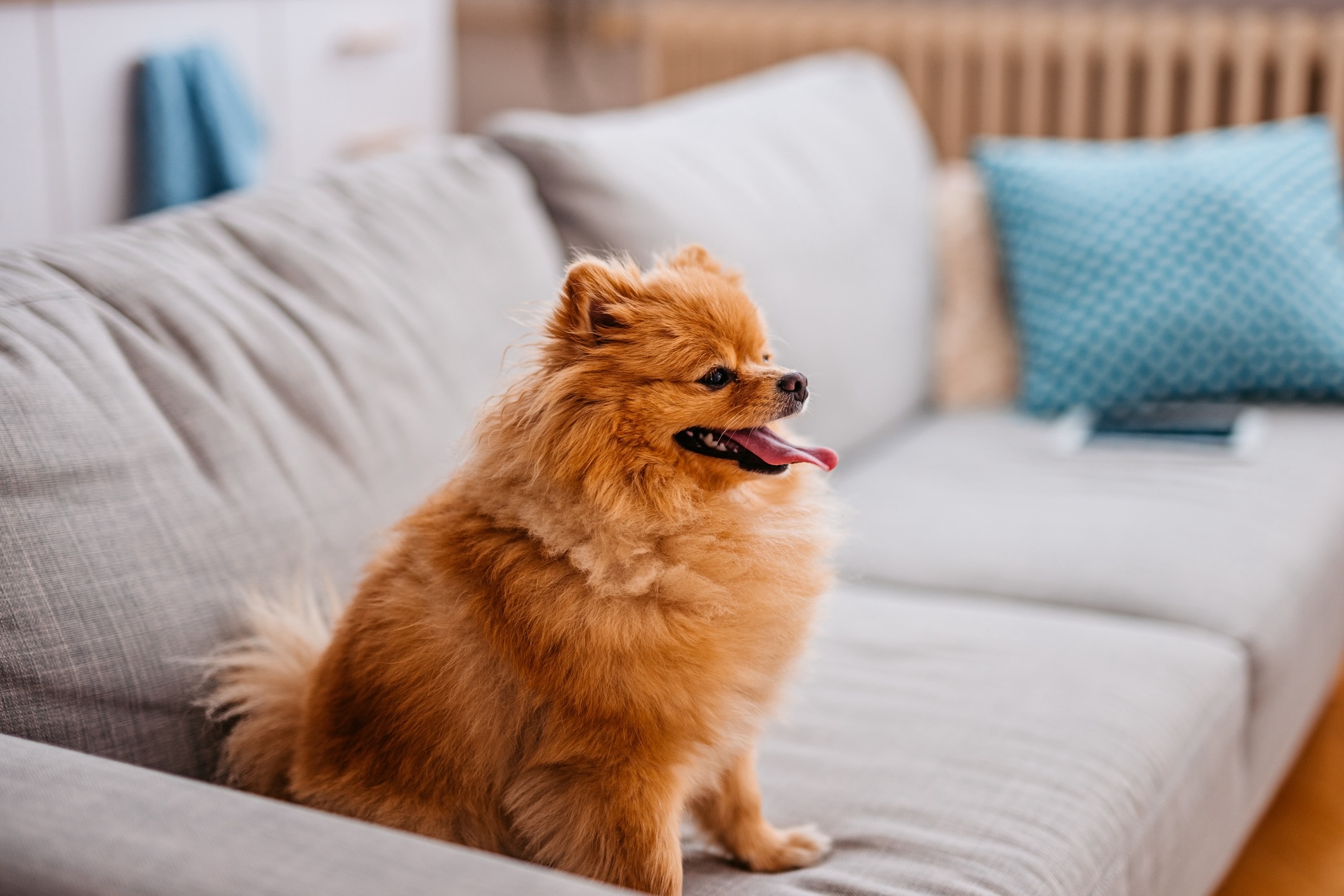
Because Pomeranians are likely to develop hypoglycemia, it’s important that they are fed a high-quality dog food. A food compliant with Association of American Feed Control Officials (AAFCO) standards is a good place to start to ensure your Pomeranian is getting all the nutrients they need.
Talk to your veterinarian to choose the best dog food, and always feed your Pomeranian a food formulated for their current life stage: puppy food for Pomeranian puppies, adult food for those at least 1 year old, and senior food for older dogs.
There are even breed-specific foods you can feed your Pomeranian.
How To Feed a Pomeranian
Pomeranian puppies should be fed frequently, with multiple mealtimes a day due to their high metabolism and their lack of fat stores.
Adult and senior Pomeranians should be fed at least three times a day to continue to prevent the risk of hypoglycemia. Senior Pomeranians should also be fed a diet with antioxidants, which can help prevent free-radical damage and help slow down some effects of aging, such as cognitive decline.
How Much Should You Feed a Pomeranian?
The exact number of calories your Pomeranian may need depends on several factors, including:
-
Lifestyle and energy level
-
Current and ideal weight
-
Age
-
Medical history
To figure out how much food to feed your Pomeranian, consult your veterinarian as well as the feeding recommendations on the bag of dog food. Remember to factor treats, chews, and food toppers into your dog’s total calorie count, too, to avoid overfeeding and obesity.
Nutritional Tips for Pomeranians
Because Pomeranians can have skin, eye, and joint issues, it may be helpful to talk to your veterinarian about adding a dog-friendly supplement to their diet. Your vet may recommend giving your dog omega-3 fatty acids (fish oil) and/or joint supplements such as chondroitin or glucosamine.
Never give your dog a supplement without talking to your vet first.
Behavior and Training Tips for Pomeranians
Pomeranian Personality and Temperament
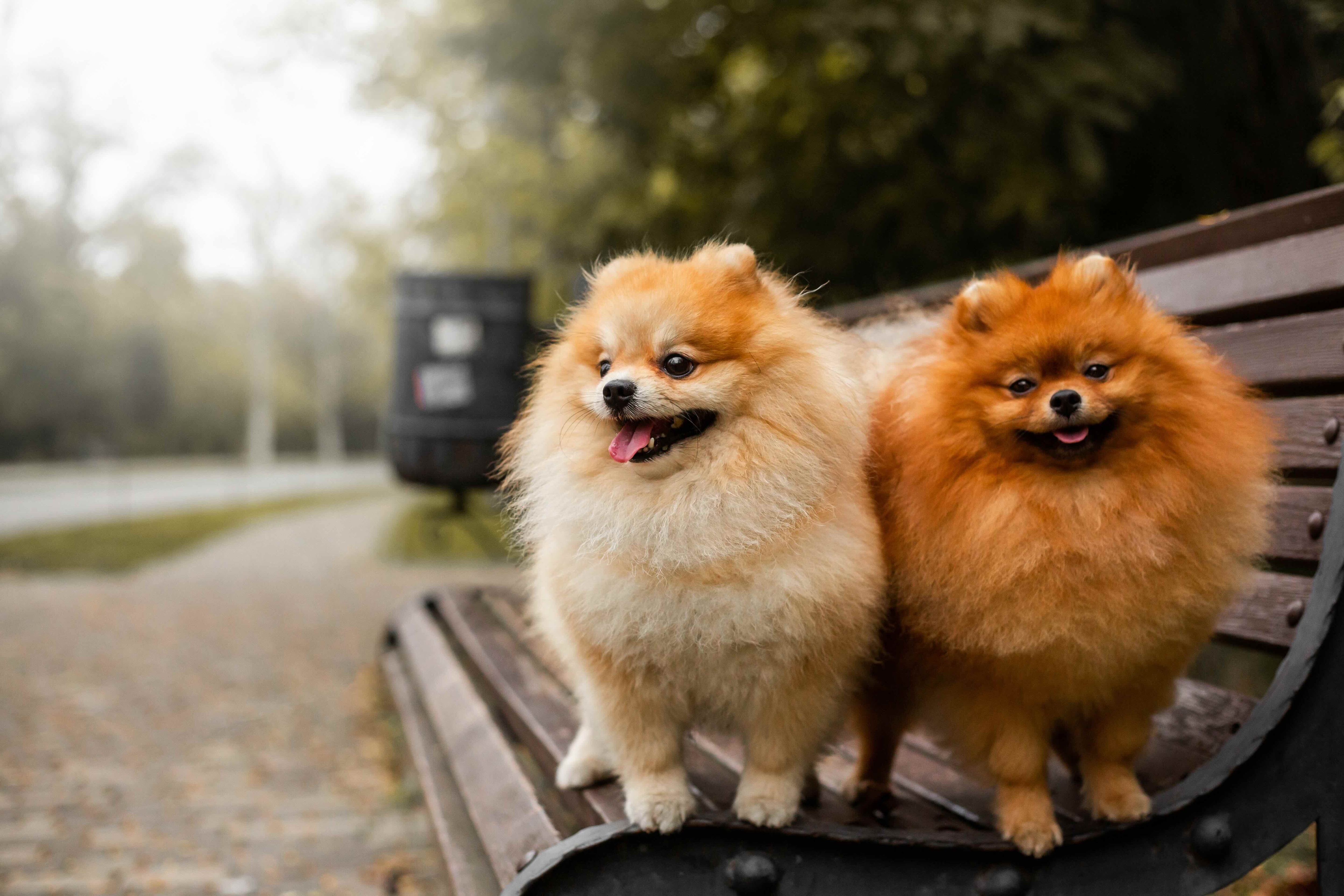
Pomeranians are intelligent dogs with large personalities. Their intelligence means they enjoy learning and do well with training and mentally stimulating activities for dogs.
But Pomeranians like their independence, and because of this, they prefer to walk on the ground instead of being carried. Despite being high-energy, their small frame ensures that they can get plenty of exercise running around the home or with a short neighborhood walk.
Pomeranian Behavior
While Pomeranians can make great companions for a lot of homes, potential pet parents must learn about positive reinforcement training and socialization to ensure they develop into well-adapted dogs. Do not expect to adopt a Pomeranian puppy and have them grow into a friendly and well-mannered dog without investing in training and socialization.
Socialization is a vital part of a Pomeranian puppy’s development, as it is with every dog. Without proper socialization and training, behaviors such as excessive barking, reactive behavior, separation anxiety, and hyperactivity can emerge.
Pomeranian Training
Pomeranians respond well to positive reinforcement-based training. They also enjoy mentally stimulating activities, including training exercises and games. Keep training sessions positive, be consistent, and use patience.
Because Pomeranians require lots of grooming, learn about touch desensitization so they are well-behaved and calm while at grooming appointments.
Fun Activities for Pomeranians
-
Walks
-
Fetch
Pomeranian Grooming Guide
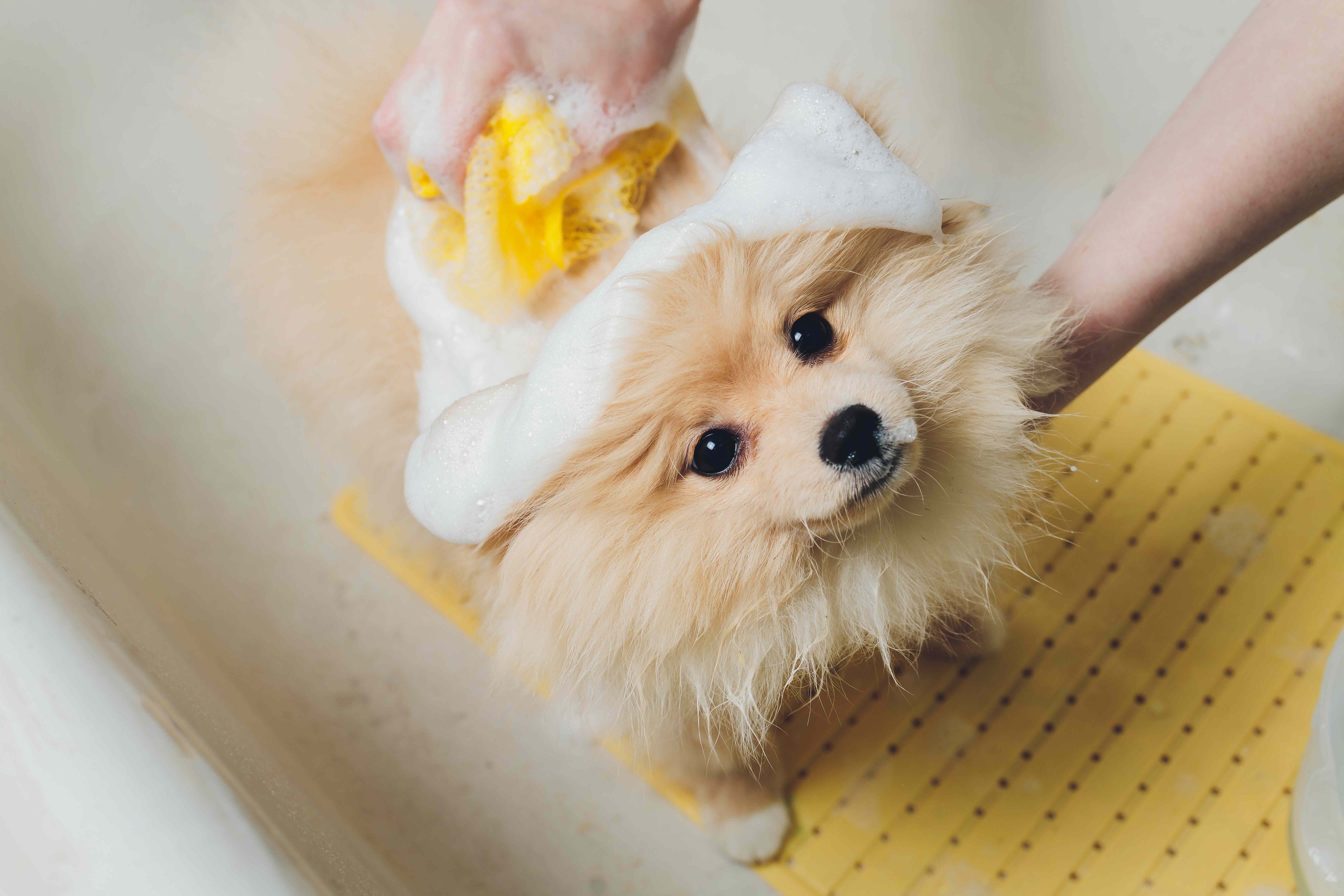
To keep their fluffy coat free from tangles and matting, Pomeranians require consistent grooming.
Skin Care
Pomeranians can have dry skin. Because of this, it may be beneficial to talk to their veterinarian about adding fish oil to their diet to help moisturize the skin.
Monitor your dog’s skin during grooming for any changes, and talk to your veterinarian if you notice any redness, flakiness, or lumps and bumps.
Coat Care
Pomeranians have very thick fur, and because of how dense and long their hair can be, routine trips to a professional groomer can be helpful to maintain coat health. A groomer can also provide a sanitary shave, which removes the hair around their rear end so waste doesn’t get caught and accumulate in the coat.
How often you bathe your dog depends on their lifestyle and medical conditions. Dogs without a history of skin disease can usually be bathed every two or three weeks. Don’t wait longer than four weeks between bathing your Pomeranian, as this can increase the risk of matted fur.
In between grooming appointments, Pomeranians should be brushed at least two or three times a week. They should be brushed daily during shedding seasons (spring and fall).
Eye Care
If you have a white Pomeranian, tear stains may be an issue. When this happens, use a dog-friendly eye cleaner to wipe away the discharge as needed.
Long hair around the face has the potential to get into the eyes and cause irritation and infection. Talk with your veterinarian or groomer to help trim the hairs around your dog’s eyes.
Because Pomeranians have so much hair around their eyes, it can cause irritation. Call your veterinarian if you see any of the following:
-
Squinting
-
Green or yellow discharge
-
Significant changes to the eye
-
Swelling
Ear Care
Because a Pomeranian’s ears are erect, they are less likely to get ear infections than floppy-eared dogs. But ear infections are still possible, and it’s important to take steps to prevent them.
After bathing your Pomeranian, use a vet-recommended ear cleaner to remove lingering water from the ear canal. This will go a long way to prevent ear infections.
Ask your vet the best method for cleaning your dog’s ears and schedule a checkup if you notice signs of an ear infection.
Considerations for Pet Parents
If you are purchasing a Pomeranian puppy, make sure the parents have been genetically tested for hip and eye problems. If you are adopting a Pomeranian from a rescue or shelter, it’s unlikely that these pets have been registered. You can still work with your veterinarian to get the necessary genetic testing to learn if your dog is at risk.
Pomeranians require quite a bit of grooming and upkeep for their thick, long coats. They are also known for being quite vocal, so you can expect some barking. This breed is known for being a big personality in a pint-sized body, so make sure you can meet their care needs.
Also, because Pomeranians are small and fluffy like many prey species, such as rabbits, be diligent about watching them while they are outside. Predatory birds and other animals may mistake your dog for their usual prey.
Pomeranian FAQs
How much does a Pomeranian cost?
The average Pomeranian price depends on where you live, the dog’s bloodline, and the breeder you work with, among other factors. Expect to pay at least $1,500, with some Pomeranian breeders selling puppies for several thousand dollars.
Is a Pomeranian a good family dog?
Yes. Pomeranians have a bright attitude, intelligence, and an active nature they can make great family dogs. However, special consideration should be given if there are or will be young children in the home. Pomeranians are small, so rough play or dropping them can cause injuries and even broken bones.
Are Pomeranians smart dogs?
Yes, Pomeranians are very intelligent.
Should I buy a teacup Pomeranian?
No. Pomeranians are already tiny dogs, and breeding them to be even smaller can cause significant health issues. Be wary about working with a breeder who claims to sell teacup Pomeranian puppies.
